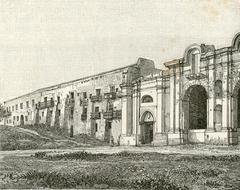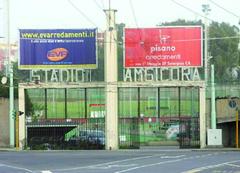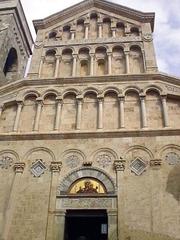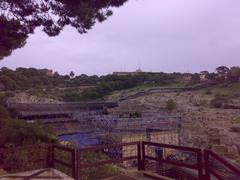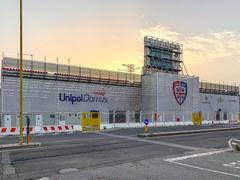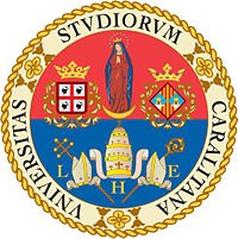
Shrine of Our Lady of Bonaria Visiting Hours, Tickets, and Travel Guide: Cagliari Historical Sites
Date: 15/06/2025
Introduction: History and Significance
Perched atop Bonaria Hill and overlooking the city of Cagliari, the Shrine of Our Lady of Bonaria (Nostra Signora di Bonaria) is one of Sardinia’s most important spiritual, cultural, and historical landmarks. Established in the late 14th century, its origins are steeped in legend: a polychrome wooden statue of the Virgin Mary holding the Christ Child—and a still-burning candle—washed ashore after a violent storm in 1370, becoming a symbol of hope and safety for sailors and the faithful alike. The name “Bonaria,” meaning “Good Air” or “Fair Winds,” reflects its enduring association with maritime protection.
As Sardinia’s patronal sanctuary, recognized by multiple papal honors, the shrine is a beacon for pilgrims, history lovers, and art enthusiasts. Its influence reaches far beyond the island, inspiring the naming of Buenos Aires and fostering Marian devotion across the globe. This guide provides detailed information on the shrine’s history, architectural evolution, visiting hours, tickets, accessibility, travel tips, and nearby attractions, ensuring you make the most of your visit to one of Cagliari’s premier historical sites (Santuariobonaria.it; Cagliari Turismo).
Contents
- Introduction
- Origins and Early History
- The Mercedarian Friars and Prophecy
- Architectural Development and Heritage
- Papal Recognition and Modern Significance
- Visiting Information
- Hours
- Tickets
- Accessibility
- Getting There
- Best Time to Visit
- Guided Tours and Events
- Nearby Attractions
- Cultural Impact and Preservation
- FAQs
- Summary and Final Tips
- Sources and Further Reading
Origins and Early History
The shrine’s story begins in 1370, when a Spanish ship, caught in a storm off Sardinia’s coast, jettisoned a heavy crate overboard. As soon as the crate hit the water, the storm miraculously subsided. The crate washed ashore at Bonaria Hill, but only the Mercedarian Friars could open it—revealing a beautifully carved statue of the Madonna and Child with a burning candle. This event became foundational to the shrine’s spiritual identity, earning it a reputation as a protector for sailors and those at sea (roman-catholic-saints.com).
The Mercedarian Friars and Prophecy
The Mercedarian Order, established at Bonaria in the early 14th century, was central to the shrine’s legacy. Father Carlo Catalan prophesied that a “Great Lady” would come to inhabit the hill, ending local illnesses and becoming a focus for devotion. The arrival of the statue and improvements in the area’s health reinforced faith in this prophecy, and the site quickly became a major pilgrimage destination (roman-catholic-saints.com).
Architectural Development and Heritage
The shrine’s architectural evolution mirrors its growing significance. The original 14th-century Gothic-Catalan sanctuary, commissioned by Alfonso IV of Aragon, features a single nave with pointed vaults and a simple limestone façade. The 18th-century Baroque basilica, built to accommodate growing numbers of pilgrims, boasts a Latin cross plan, a grand dome, ornate chapels, and a monumental bell tower. The adjacent Mercedarian convent houses a museum of votive offerings and religious artifacts, deepening the visitor’s connection to Sardinian history (Sardegna Turismo; Bonaria Official Site).
Notable interior highlights include the polychrome wooden statue of the Madonna and Child, marble altars, frescoes by Filippo Figari and Giovanni Marghinotti, and stained glass windows depicting Marian and maritime themes. The basilica also contains a crypt with historical tombs, including that of Peter IV of Aragon.
Papal Recognition and Modern Significance
Our Lady of Bonaria’s stature has been affirmed by numerous popes. In 1908, Pope Pius X declared her patroness of Sardinia, and successive papal visits—by Paul VI, John Paul II, Benedict XVI, and Francis—have underscored the shrine’s importance. In 2008, Pope Benedict XVI granted the statue a canonical coronation and the Golden Rose, a rare honor in the Catholic world (Wikipedia; Catholic Shrine Basilica).
The devotion to Our Lady of Bonaria spread globally, most famously influencing the naming of Buenos Aires by Spanish conquistadors, cementing a spiritual and cultural bond between Sardinia and Argentina.
Visiting the Shrine: Hours, Tickets, and Accessibility
Visiting Hours
- Basilica and Sanctuary: Open daily, typically 7:00 AM to 12:00 PM and 4:00 PM to 8:00 PM.
- Museum: Usually open during the same hours, with possible variations on feast days and special events.
Check the official website for the latest updates.
Admission and Tickets
- Basilica & Sanctuary: Free entry.
- Museum: Modest admission (usually under €5); supports preservation (Sardegna Turismo).
Accessibility
- Step-free access via ramps and elevators
- Accessible restrooms and seating
- Parking for people with disabilities
- Some outdoor areas may have uneven surfaces
Getting There
- By Foot: 15–20 minute uphill walk from Via Roma, Cagliari’s main boulevard
- By Bus: Lines 5 and 6 to Viale Bonaria
- By Car: Parking available, but limited during major events (Sardegna Turismo)
Best Time to Visit
- Early mornings and late afternoons offer tranquility and beautiful light
- Major feasts: April 24th (main celebration), March 25th (anniversary of the statue’s arrival), and the first Sunday of July (procession to the sea)
- Expect crowds during special events
Guided Tours and Special Events
- Guided tours available in Italian and sometimes English (book in advance for groups)
- Annual processions, open-air masses, and Marian festivals
- Virtual tours also offered online (Bonaria Official Site)
Nearby Attractions in Cagliari
- Cagliari Cathedral: Historic church in the old town
- Roman Amphitheater: Archaeological landmark
- National Archaeological Museum: Sardinian history and artifacts
- Poetto Beach: Popular seaside retreat
Accommodations such as Cerdèna Rooms, Kaliè Rooms, and Casa Diaz are close by (Sardegna Turismo).
Cultural Impact and Preservation
The shrine’s museum displays centuries of ex-voto offerings—model ships, paintings, and silver hearts—testifying to the Madonna’s role as protector of sailors and Sardinia’s maritime legacy. The annual festivals and processions blend faith and local tradition, reinforcing Sardinian identity and community spirit.
Ongoing conservation ensures the preservation of both the sacred and artistic heritage, with recent restorations improving accessibility, lighting, and historical interpretation (Bonaria Official Site).
Frequently Asked Questions (FAQ)
Q: What are the visiting hours for the shrine?
A: Typically 7:00 AM–12:00 PM and 4:00 PM–8:00 PM, but check the official website for updates.
Q: Is there an entry fee?
A: Entry to the basilica and sanctuary is free; the museum charges a small fee.
Q: Is the shrine accessible for visitors with disabilities?
A: Yes, with ramps, elevators, and accessible restrooms.
Q: Are guided tours available?
A: Yes, in Italian and occasionally English; advance booking recommended for groups.
Q: Can I take photographs?
A: Photography is allowed in most areas, except during Mass and special ceremonies.
Q: How do I get there from the city center?
A: On foot (15–20 minutes), by bus, or by car (limited parking).
Visuals and Virtual Tours

Alt text: Exterior view of the Shrine of Our Lady of Bonaria, a prominent historical site in Cagliari, Sardinia.
Alt text: Colorful frescoes depicting Marian scenes inside the dome of the Shrine of Our Lady of Bonaria.
Explore the virtual tour of the Shrine.
Summary and Final Tips
The Shrine of Our Lady of Bonaria is a living testament to faith, maritime tradition, and Sardinian identity. Its miraculous history, architectural beauty, and panoramic setting make it an essential destination for visitors to Cagliari. Free admission, accessibility, vibrant festivals, and proximity to other historical sites ensure a rewarding experience. For the latest visiting hours, tickets, and event details, always check the official shrine website and Sardegna Turismo.
Enhance your visit by downloading the Audiala app for guided audio tours, event alerts, and insider tips on Sardinia’s heritage. Enjoy your journey into Cagliari’s rich history and culture!
Sources and Further Reading
- Our Lady of Bonaria – Roman Catholic Saints
- Wikipedia: Shrine of Our Lady of Bonaria
- Catholic Shrine Basilica: Sanctuary of Our Lady of Bonaria
- The Catholic Travel Guide
- Cagliari Turismo: Basilica and Sanctuary NS di Bonaria
- Sardegna Turismo: Santuario e Basilica di Nostra Signora di Bonaria, Cagliari
- Bonaria Official Site
- Sardegna Turismo: Nostra Signora di Bonaria
